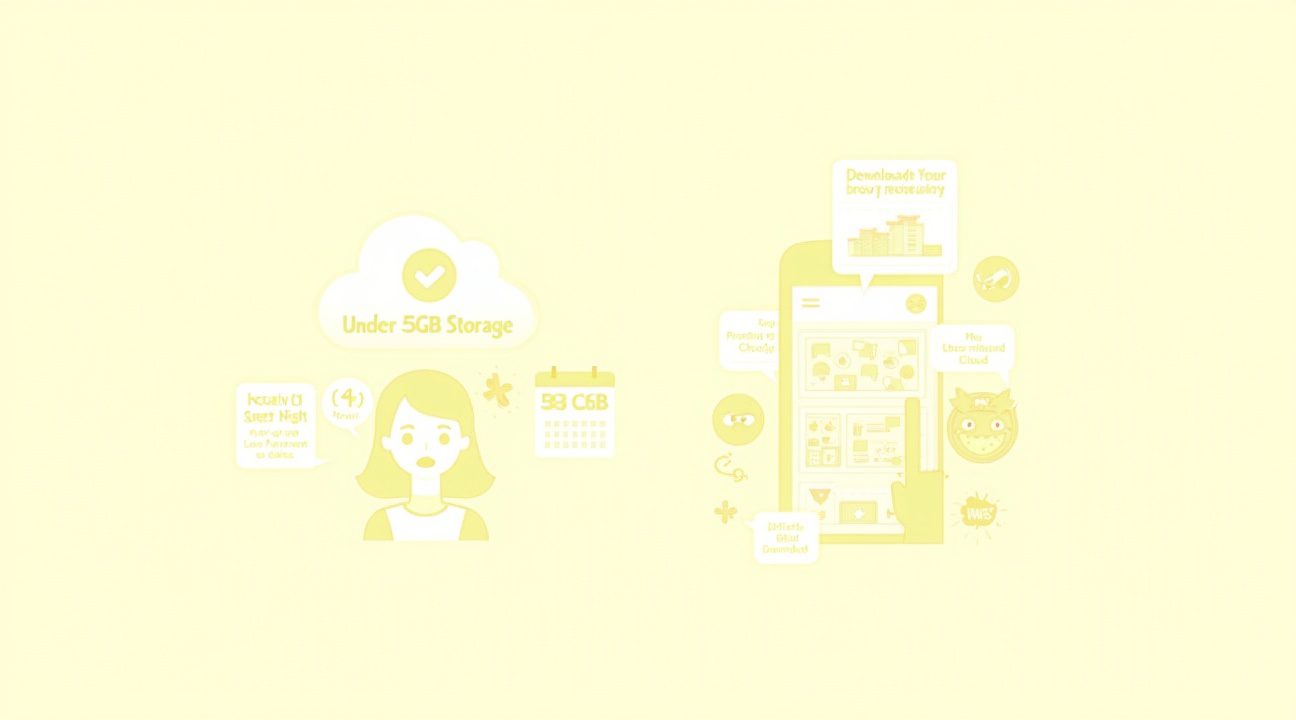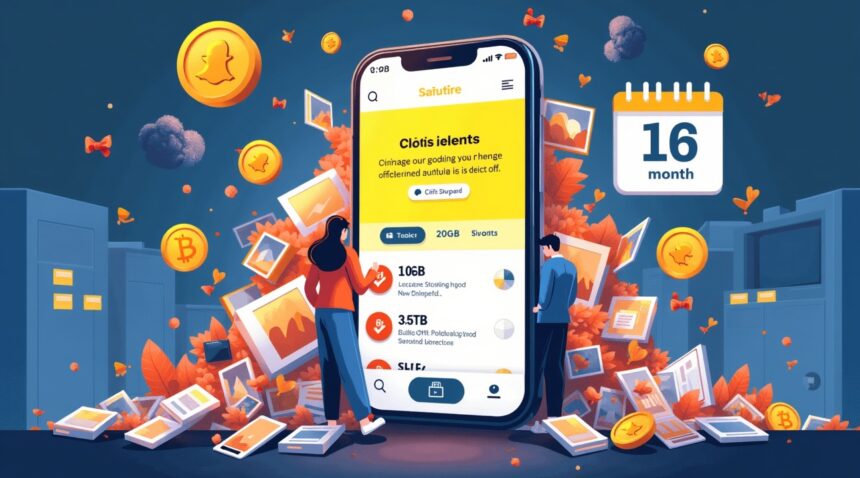Snapchat has officially ended its era of unlimited free storage for user memories, capping it at 5GB for free users and launching paid subscription tiers for those requiring more space.
Key Takeaways
- Most casual Snapchat users will not be affected since they typically store less than 5GB of content.
- Heavy users exceeding 5GB will have a 12-month grace period to upgrade, download, or delete content.
- Three paid plans are available: 100GB for $1.99/month, 250GB with Snapchat+ for $3.99/month, and 5TB with Snapchat Platinum for $15.99/month.
- Over 1 trillion Memories have been saved since 2016, increasing infrastructure costs significantly.
- Snapchat aligns with tech giants like Apple and Google by monetizing storage to diversify beyond ad revenue.
Business Strategy and Implications
Snapchat’s move to limit free storage marks a significant shift in its business model. Growing server expenses due to user-generated visual content have driven the need to monetize storage. Since launching Snapchat Memories in 2016, infrastructure demands have risen exponentially.
Users most impacted by this policy include content creators, avid travelers, and social influencers who regularly exceed the 5GB threshold. These users face the decision of paying monthly fees or managing their storage through downloads and deletions.
Targeted Pricing Tiers
Snapchat’s pricing model effectively caters to different user needs:
- Free tier: 5GB limit, suitable for casual users.
- $1.99/month: 100GB plan for moderate users.
- $3.99/month: 250GB offering included in Snapchat+.
- $15.99/month: 5TB Snapchat Platinum for professional or high-volume users.
Grace Period and User Flexibility
The platform offers a 12-month grace period to users who currently exceed the 5GB limit. While they can still access older content, they won’t be able to save new memories unless they buy more space or manage existing content.
Comparing to Industry Norms
This strategic pivot reflects industry trends. Apple charges users beyond 5GB for iCloud storage, and Google applies quotas across Photos and Drive services. These companies have demonstrated that paid cloud storage is both profitable and market-accepted.
Ad Revenue vs Subscriptions
With increasing uncertainty in ad revenue due to economic shifts and market competition, Snapchat seeks stability through subscriptions. Monthly storage plans provide a dependable income stream in contrast to volatile advertising returns.
Storage Management Strategies for Users
Users can manage their Snapchat storage efficiently in several ways:
- Download memories to local device storage to avoid subscription fees.
- Delete less important memories to make room for new content.
- Use alternative cloud storage solutions such as Google Drive or Dropbox for backup and archive purposes.
Impact on Content Creators
Professional users who used Snapchat Memories as an archive or portfolio must now adjust. Budgeting for storage or altering their workflow is necessary to maintain access to high-volume content.
Aligning with Subscription Culture
The timing of Snapchat’s change coincides with growing public acceptance of subscription models. With services like Netflix, Spotify, and cloud apps normalizing monthly payments, users may be more open to investing in cloud storage.
Increased Infrastructure Demands
Snapchat’s server needs mimic those of other platforms like Instagram or TikTok. The weight of video content — much larger than images or text — drives up costs, making monetization essential.
Alternative Backup Options
In addition to Snapchat-paid plans, users can consider:
- External hard drives for one-time local storage.
- Cloud platforms like Amazon, Microsoft OneDrive, or Dropbox that offer scalable pricing and advanced features.
A Deliberate Transition
Snapchat’s new policy reflects a calculated approach to balancing user needs and business sustainability. While free users retain access to the platform, storage-heavy users fund its growing infrastructure through subscriptions.
From App to Platform
This evolution positions Snapchat as more than just a messaging app. It becomes a visual content platform where users must prioritize meaningful, high-quality moments over quantity, embracing a more intentional content strategy.
Free Ride Over: Snapchat Caps Storage at 5GB, Introduces Paid Plans
Snapchat’s era of unlimited free storage for Memories has officially ended. The platform now restricts free storage to just 5GB, marking a significant shift in how users can preserve their Snaps beyond the traditional 24-hour disappearing window.
The End of Unlimited Free Storage
For years, users enjoyed essentially limitless space to store their favorite Snaps through the Memories feature. This generous policy allowed people to build extensive digital collections without worrying about storage constraints. However, Snapchat has decided to monetize this service by implementing storage caps and introducing paid subscription tiers.
Users who’ve accumulated thousands of Snaps over the years will likely find themselves exceeding the 5GB threshold quickly. High-resolution photos and videos consume substantial storage space, meaning frequent users might hit this limit faster than expected. The change particularly impacts power users who’ve relied on Memories as their primary photo storage solution.
Grace Period and User Options
Snapchat isn’t throwing users into the deep end immediately. The company provides a 12-month grace period for those already exceeding the 5GB limit. During this temporary extension, existing content remains accessible while users decide their next steps.
Users facing the storage cap have several options available:
- Upgrade to a paid storage plan to maintain full access to their Memories collection
- Download existing content directly to their device’s local storage
- Delete older or less important Snaps to stay within the free 5GB allowance
- Selectively curate their collection by removing duplicates or low-quality content
The grace period offers breathing room, but users shouldn’t delay making decisions. Once the temporary storage expires, access to excess content may become restricted. Smart users will use this time to evaluate which memories truly matter and deserve premium storage space.
This move aligns with broader industry trends where social media platforms increasingly monetize previously free features. Snapchat’s decision reflects the growing costs of maintaining vast amounts of user data and the company’s push for sustainable revenue streams beyond advertising.
The storage limitation forces users to be more intentional about what they save. Rather than reflexively storing every Snap, people must now consider the value of each memory. This constraint might actually improve the quality of saved content by encouraging more thoughtful curation practices.
What Your Money Gets You: Breaking Down Snapchat’s New Storage Tiers
Snapchat has rolled out three distinct paid storage options, each designed to meet different user needs and budgets. I’ll walk you through what each tier offers so you can make an informed decision about which plan fits your usage patterns.
Storage Plan Options and Pricing
The platform now offers these three paid storage solutions:
- 100GB Plan costs $1.99 per month and provides basic expanded storage for casual users
- 250GB Plan comes bundled with Snapchat+ subscription at $3.99 per month, including premium features
- 5TB Plan is part of Snapchat Platinum for $15.99 per month, targeting power users and content creators
The middle-tier option stands out because it combines storage expansion with Snapchat+ premium features. This subscription includes exclusive filters, priority support, and early access to experimental features, making it particularly attractive for users who want both storage and enhanced functionality.
What Happens When You Don’t Subscribe
Users who remain on the free 5GB tier face automatic content management. Once you exceed this threshold, Snapchat preserves your oldest Snaps but begins deleting newer content that pushes you over the limit. The platform provides a grace period, giving you time to choose a plan or manually manage your content.
I recommend taking proactive steps to protect your memories before hitting the storage wall. Download important Snaps to your device or back them up to cloud storage services. This approach ensures you won’t lose precious moments during the transition period or if you decide against upgrading.
The pricing structure reflects current market trends, similar to how major platforms have shifted toward subscription models. Content creators and heavy users will likely gravitate toward the 5TB option, while casual users might find the 100GB plan sufficient for their needs.
Consider your typical usage patterns when evaluating these options. If you frequently save Snaps, create Stories, or maintain extensive chat histories, the larger storage tiers become essential investments in preserving your digital memories.
By the Numbers: Massive Memories Usage Drives Storage Crackdown
The staggering scale of Snapchat’s Memories feature has reached unprecedented levels, with more than 1 trillion Memories saved since its launch in 2016. This massive adoption demonstrates how users have embraced the platform’s storage capabilities far beyond what Snapchat initially anticipated.
The sheer volume of content being stored has created significant infrastructure challenges for the company. With users saving everything from daily moments to special occasions, the storage demands have grown exponentially year over year. This explosive growth has forced Snapchat to reconsider its free storage model and implement new policies to manage costs.
Who’s Really Affected by the Changes
Despite the overwhelming numbers, the majority of Snapchat users maintain relatively modest storage footprints. Data shows that most users have less than 5GB of saved content in their Memories, placing them well below any potential charging thresholds. These everyday users can continue enjoying the service without worrying about additional fees.
However, the policy changes specifically target what industry experts call super-users – those who store massive amounts of content. These heavy users represent a small percentage of the user base but consume disproportionate amounts of server space and storage resources. Their usage patterns include:
- Saving multiple videos daily over extended periods
- Storing high-resolution photos and lengthy video clips
- Maintaining archives spanning several years of content
- Using Snapchat as a primary photo backup solution
The financial impact of supporting these super-users has become unsustainable for Snapchat’s current business model. While social media platforms traditionally offered unlimited storage, rising infrastructure costs have forced companies to reassess these offerings.
Storage costs continue climbing as users create higher-quality content. Modern smartphones capture 4K videos and high-resolution photos that consume significantly more space than content from just a few years ago. Each super-user storing hundreds of gigabytes creates substantial ongoing expenses for Snapchat’s data centers.
The company’s decision reflects broader industry trends where platforms must balance user experience with operational sustainability. Similar storage limitations have appeared across various digital services as companies grapple with exponential data growth and associated costs.
For super-users who’ve relied on Snapchat as their primary storage solution, this change represents a significant shift. Many have accumulated years worth of memories, treating the platform as a personal archive rather than just a messaging app. The transition period will likely prompt these users to either pay for continued storage or migrate their content elsewhere.
Snapchat’s challenge lies in implementing these changes without alienating its most engaged users. Super-users often serve as content creators and influencers who drive platform engagement. Losing these users could impact the platform’s overall vitality and user-generated content quality.
The company must also communicate these changes effectively to avoid user backlash. Clear messaging about who will be affected and when charges begin will be crucial for maintaining user trust. Transparency about storage limits and pricing will help users make informed decisions about their content management strategies.
These statistics reveal the massive scale behind Snapchat’s storage challenges. With 1 trillion Memories representing countless hours of user-generated content, the platform has essentially become an unofficial backup service for millions of users worldwide. The infrastructure required to maintain this level of service represents a significant ongoing investment that free models can no longer support.
Moving forward, Snapchat’s approach will likely influence how other social platforms handle storage limitations. The balance between user expectations and business sustainability continues evolving as digital content consumption grows exponentially across all demographics.

Snapchat Joins the Club: Following Apple and Google’s Playbook
Snapchat’s decision to charge for storing old posts aligns the company with industry giants who’ve already mastered the art of cloud storage monetization. Apple’s iCloud and Google Photos have demonstrated that users will pay for additional storage when their digital lives exceed free tier limitations.
Learning from Established Models
Apple and Google have successfully transformed storage needs into steady revenue streams by offering tiered pricing structures that scale with user demands. Users start with free storage allocations but inevitably require more space as their photo libraries, videos, and app data accumulate over time. This proven model shows that people value their digital memories enough to pay for secure, accessible storage solutions.
Snapchat’s strategic pivot represents more than just following trends—it’s a calculated move to reduce dependence on advertising revenue. While social media platforms have traditionally relied on ad dollars, subscription-based services offer more predictable income streams that aren’t subject to market fluctuations or advertiser pullbacks.
Diversifying Beyond Traditional Revenue
The shift toward charging for storage taps into a fundamental human behavior: the desire to preserve memories. Users who’ve invested years in building their Snapchat collections won’t easily abandon those archived moments. This creates a captive audience willing to pay for continued access to their digital history.
Major tech companies have capitalized on this attachment by offering seamless integration between devices and automatic backup features that make storage feel essential rather than optional. Users become accustomed to having their content available across all their devices, making the transition from free to paid storage feel natural rather than forced.
Snapchat’s entry into this market acknowledges that high-storage users represent a valuable segment willing to pay premium prices for expanded capabilities. These power users often:
- Generate the most content
- Engage most frequently with the platform
- Demonstrate the highest lifetime value
By implementing storage fees, Snapchat can capture additional revenue from its most active community members while maintaining free access for casual users.
The timing aligns with broader industry trends where subscription models have proven more sustainable than advertising-dependent approaches. Users have shown increasing willingness to pay for digital services that enhance their daily experiences, particularly when those services protect and organize their personal content. Snapchat’s move reflects an understanding that storage isn’t just about space—it’s about preserving digital relationships and memories that users consider irreplaceable.

What This Means for You: Most Users Safe, Heavy Users Need Action Plan
I expect the vast majority of Snapchat users won’t feel any impact from this storage policy change. Casual users who snap photos occasionally and don’t save extensive amounts of content will likely remain well below the 5GB threshold. These users can continue using Snapchat Memories exactly as they always have, without any interruption to their experience or additional costs.
Heavy Users Should Start Planning Now
Heavy content creators and frequent Snapchat users need to take a proactive approach. I recommend these users check their current Memories storage immediately to understand where they stand relative to the new limit. Users who regularly save high-quality photos, videos, or maintain large collections of Snaps should start developing a strategy for managing their content.
The options available to heavy users include several practical approaches:
- Upgrade to a paid storage tier when Snapchat releases pricing details
- Download important content to personal devices or cloud storage services
- Delete older, less meaningful Snaps and videos that no longer hold value
- Prioritize which memories are truly worth keeping in the platform
- Set up a regular content review schedule to avoid future storage issues
I notice that Snapchat has provided a generous 12-month grace period, which gives users ample time to make decisions about their content. This timeline suggests the company understands that managing years of accumulated memories requires careful consideration and planning.
The storage policy directly addresses Snapchat’s infrastructure costs while maintaining free access to core features for most users. This approach mirrors strategies used by other social media platforms, where basic services remain free but premium storage or features require payment. Much like how major platform acquisitions often lead to monetization changes, Snapchat appears to be balancing user experience with operational sustainability.
For users approaching the 5GB limit, I suggest starting with content downloaded several years ago. Older Snaps often have lower personal value compared to recent memories, making them ideal candidates for deletion. Videos typically consume more storage space than photos, so reviewing video content first can free up significant space quickly.
The timing of this announcement also indicates Snapchat’s confidence in user retention. The company clearly believes that heavy users value their stored memories enough to either pay for additional storage or invest time in content management rather than abandon the platform entirely. This calculated risk suggests internal data shows strong user attachment to the Memories feature.
I anticipate that power users who’ve built extensive personal archives on Snapchat will need to weigh the convenience of cloud storage against the cost of premium tiers. Some may choose to migrate their content to alternative storage solutions, while others will find the paid options worthwhile for seamless integration with their daily Snapchat usage.
The policy change also creates an opportunity for users to curate their digital memories more intentionally. Rather than automatically saving every piece of content, users might become more selective about what deserves permanent storage. This shift could actually enhance the value of saved memories by focusing on truly meaningful moments.
Snapchat’s decision to maintain free storage for typical usage patterns demonstrates understanding of their user base demographics. College students and younger users, who represent a significant portion of the platform’s audience, often operate with limited budgets but also tend to use storage more moderately than content creators or business users.
I expect Snapchat will release detailed pricing information and migration tools well before the grace period expires. The company has strong incentives to make any transitions as smooth as possible to minimize user frustration and potential platform abandonment. Users should monitor official communications for updates on pricing tiers and storage management features that may simplify the transition process.

Behind the Decision: Infrastructure Costs Drive Revenue Strategy Shift
Snapchat’s decision to charge for long-term post storage stems from mounting infrastructure expenses that have grown alongside its expanding user base. I’ve observed how the platform’s ephemeral nature, once its defining characteristic, has evolved to accommodate users who want permanent storage options. This evolution comes with significant financial implications that the company can no longer absorb entirely through advertising revenue alone.
Strategic Revenue Diversification Beyond Traditional Advertising
The storage fee initiative represents Snapchat’s calculated move to reduce dependency on advertising dollars while addressing operational sustainability. I notice this approach mirrors successful strategies implemented by tech giants who’ve discovered that charging heavy users for premium storage creates a stable revenue stream. The company targets users with extensive storage needs rather than implementing blanket charges across its entire user base.
Several factors drive this strategic pivot:
- Data center maintenance and expansion costs continue rising as user-generated content volumes increase exponentially
- Server infrastructure requires constant upgrades to handle high-resolution photos and videos that users now expect to store indefinitely
- Backup and redundancy systems demand significant investment to ensure data protection and accessibility
- Energy costs for running massive server farms represent an ongoing operational expense that scales with storage demands
This targeted approach allows Snapchat to maintain its free service model for casual users while generating revenue from those who consume disproportionate storage resources. I see parallels with how major platform acquisitions often lead to monetization strategy overhauls as new ownership seeks sustainable business models.
The company’s infrastructure costs have multiplied as users increasingly treat Snapchat as a permanent storage solution rather than a temporary messaging platform. Videos and high-resolution images consume substantially more server space than the simple text-based snaps that originally defined the platform. This shift in user behavior necessitates a corresponding shift in how Snapchat structures its revenue model.
By implementing storage fees strategically, Snapchat positions itself to fund necessary infrastructure improvements while maintaining competitive free tiers. The approach ensures that users who generate the highest storage costs contribute proportionally to the platform’s operational expenses. This revenue diversification reduces vulnerability to advertising market fluctuations that have historically impacted social media companies’ financial stability.

Sources:
“Introducing Memories Storage Plans,” Snap.com Newsroom
“Snapchat plans to start charging for storing old posts,” BetaNews
“Snapchat caps free Memory storage, launches paid storage plans,” TechCrunch
“Snapchat caps free Memories storage, launches paid subscription tiers,” Storyboard18
“Snapchat Memories may no longer be free: Here’s everything you need to know about new storage plans and backups,” Times of India
“Will You Have To Pay for Snapchat Memories?” Mandatory


